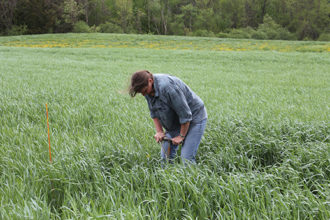Cornell University agronomist Quirine Ketterings conducted her Northeast SARE Research and Education project to better understand the incorporation of winter cereal cover crops— triticale, winter rye and wheat—into silage corn rotations. This double crop system enables farmers to provide both corn and cover crops as livestock feed. Because growing cover crops as dairy forages means they need to be managed like cash crops, Quirine and her team were particularly interested in learning the nitrogen (N) needs of these covers during green-up. Nitrogen management is important to not only gain good yields but is also a key factor in achieving optimal dietary protein as a dairy feed.
The project team installed 19 field trials on farms across New York to determine optimum N rates of winter cereal cover crops when double cropped with silage corn. Further, Quirine expanded the team to include 47 farmers and 21 farm advisors (extension, government agencies, private sector consultants) allowing the project to collect similar on-farm data on an additional 44 trial sites throughout the state.
Research results showed that site characteristics play a role in N needs for winter cereals grown for forage. Therefore, fields need to be evaluated on an individual basis to determine whether or not N should be applied in the spring.
From the collection and analysis of yields, soil and forage quality, cover crop planting date, and site characteristics (like tile drainage, soil types and fertility history), the team developed a N recommendation system for growing winter cereal covers for forage. They also created an Excel calculator to estimate nutrient levels of winter cereal cover crops. In addition, the team conducted an economic analysis of growing cover crops in a double crop system. They found that winter cereals can be grown profitably in corn rotations even when fertilizers are needed or silage yields are slightly reduced. If winter cereal covers are used for forage, they should be managed as a crop with attention to planting dates, fertility management, and harvest quality.
As a result of the project, eleven farmers made on-farm changes to expand their use of cover crops, use double cropping and/or change N application rates to the winter cereals at green-up. One farmer collaborator said, “The on-farm research really helps to see what can work. Double cropping with winter triticale is great for my feed program and fits in beautifully with short rotations that keep soil covered to help my farm stay productive into the future.”
